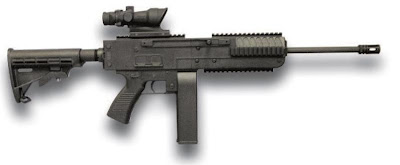
By now, most everyone in the world has some knowledge of Unmanned Ariel Vehicles (
UAVs). They are talked about on the news, especially the news dealing with Afghanistan and Pakistan and the war against Al
Qaeda and the Taliban going on there. The
UAV that is most well known is the Predator, a fixed wing, propeller driven, remote control airplane on steroids. What some people have yet to realize is the fielding of large numbers of different types of
UAVs has fundamentally changed the way wars are and will be fought. The
UAV revolution will be just as important as the advent of combat aviation in WWI or the massive changes in tactics and strategy of helicopter warfare in the Vietnam War.

On to today's subject, the
Northop Grumman MQ-8 Fire Scout
UAV. While the Department of Defense has been using unmanned vehicles for quite some time, most were used as aerial targets or close (
ish) range reconnaissance, target acquisition, and battle damage assessments. With the technology boom of the 1990's
UAVs began to change from what some might call expensive and marginally useful toys to weapons of war in their own right. The Fire Scout is being developed to function as a multi-role
UAV, capable of performing reconnaissance, situational awareness, and precision targeting support. This includes mounting weapons on the stub wings such as the Hellfire missile, which has been used to a great effect from helicopters and Predator
UAVs, the Viper Strike laser guided weapons, and the Advanced Precision Kill Weapon System (
APKWS) which is an updated, laser-guided version of the 70 mm folding-fin rocket, which many in the Army feel is very well suited to modern combat, especially in built up areas. The
MQ-8 also has a very capable sensor suite, with options to have some or all of the following: a day/night scope with laser target designator, a mine field detection system, a synthetic aperture radar with the ability to track moving targets, and more. The Fire Scout was designed to be controlled over a data link derived from
RQ-4 Global Hawk
UAV, operating over a line of sight to a distance of 172 miles. The control system was to be fitted onto a ship, or could be carried on a Humvee vehicle for U.S. Marine and Army service.

Fire Scout, as a rotor winged vehicle, brings some new capabilities that
UAVs have not had in the past. The ability to take off and land virtually anywhere is an amazing leap forward. Older fixed wing
UAVs were often caught in giant nets suspended off the side of a ship. Obviously, this is probably not the easiest or most efficient way to do things and sometimes caused the vehicles to be damaged or lost. The Fire Scout has already demonstrated its ability to land on the deck of a moving ship, the
USS Nashville, which was a first for the US Navy, and probably the world. Mobility and maneuver are some of the most important facets of war, one of the only things more important is timely intelligence. The Fire Scout will increase them all.

As the technology of
UAVs has continued to evolve, military scientists, strategists, and planners have found new roles for the
UAV to explore. Modern war, especially in an urban area, is very high tempo and for the soldier or Marine on the ground, that can often mean a lot of firing. Resupply in years past was a Jeep or truck with some crates on the back, driving from the rear up to the front lines. As the US Military has shrunk in size considerably in the last 50 years and conflicts have become more unconventional, supply lines are increasingly under attack. And if you can't go through it, over it is an option as well. One possible function of the Fire Scout is that of a emergency resupply vehicle. Now it will be much easier to support small units, operating far from friendly areas and supply dumps. It can take a load of up to 200 pounds of supplies, which is a significant amount of bullets and beans. Fire Scout is expected to have a range of at least 125 miles and to be able to operate up to 20,000 feet. Imagine this, a small detachment of soldiers are occupying a vital mountain peak in Afghanistan, providing intelligence. The enemy wants them out of there and launches an
assault on their position. How long can they stay up there? Well, they certainly won't last long without help. The Fire Scout could fly in, drop a package with ammunition, medical supplies and water and food, all without risking a single life. A flight of three could come in and two could provide cover from the air for the third. This is a game changer, folks. The
MQ-8 has been undergoing the normal testing and evaluation for a few years now and is expected to be fielded by the Navy aboard the
USS McInerney in 2009.





































